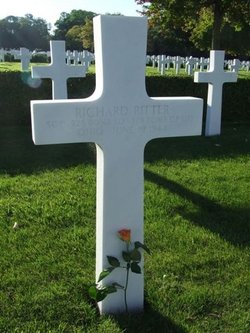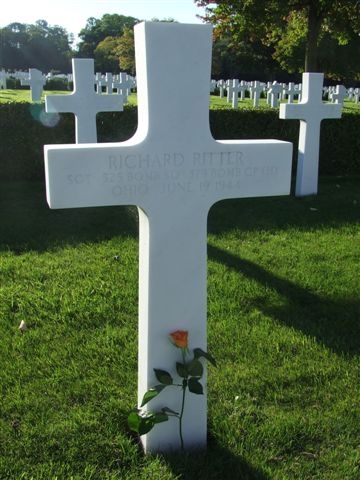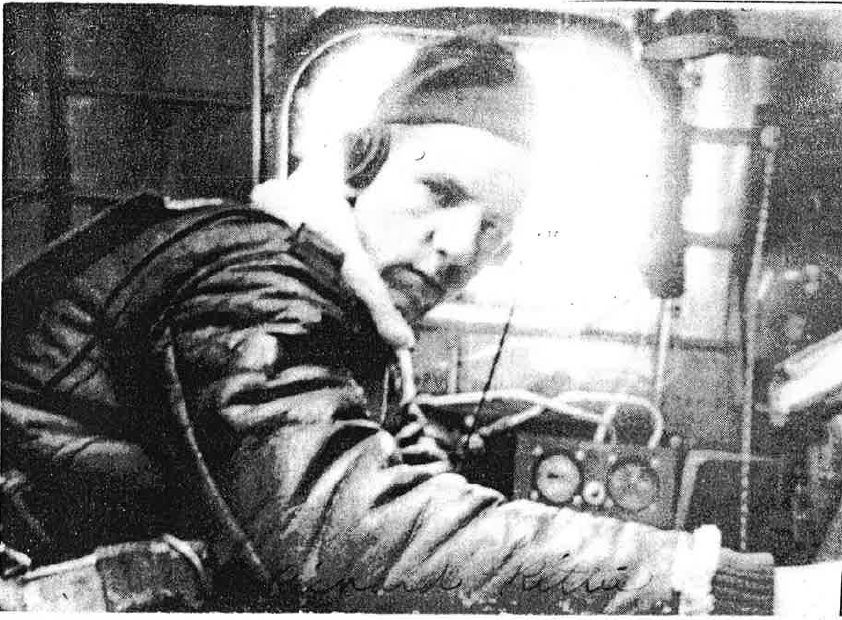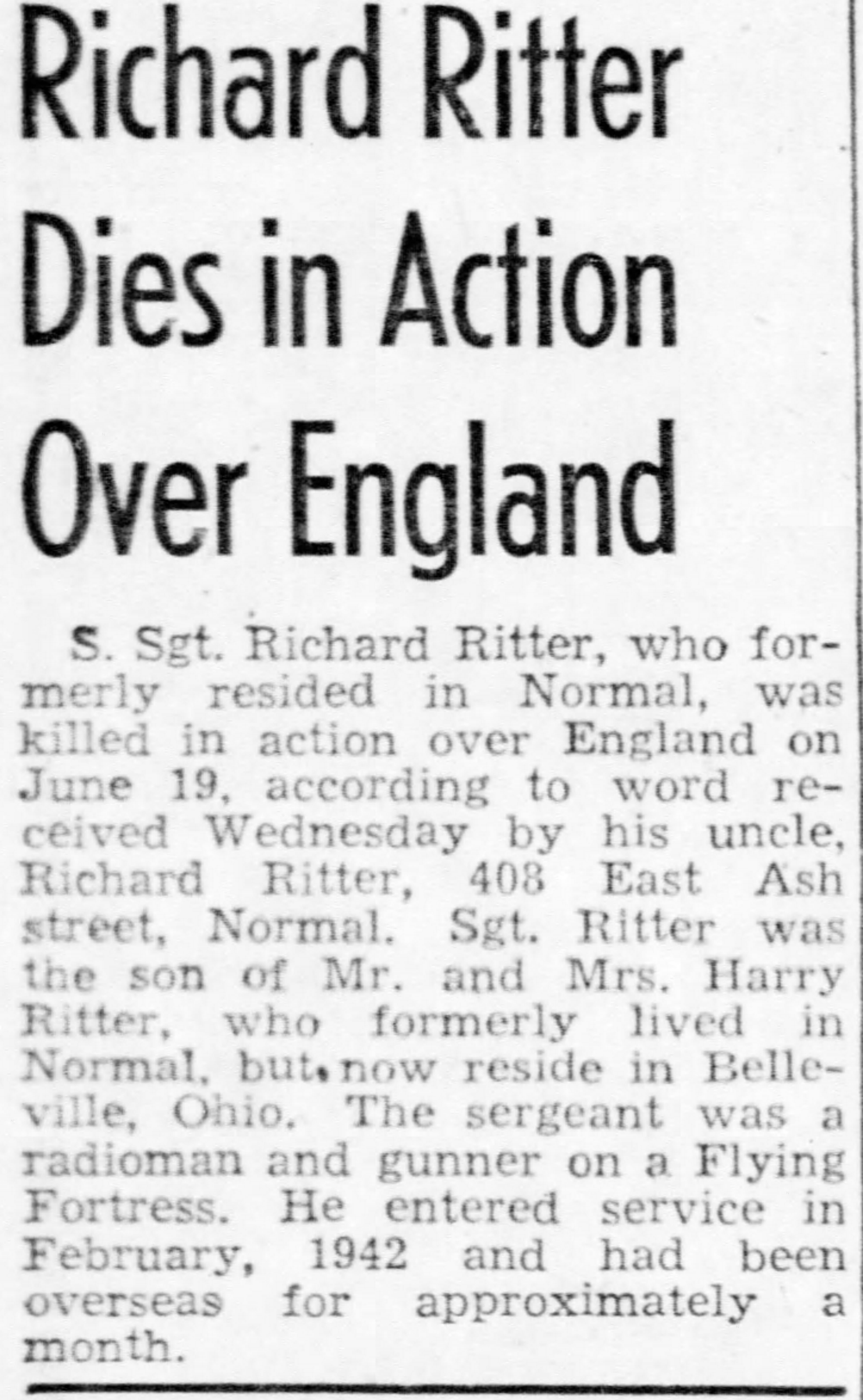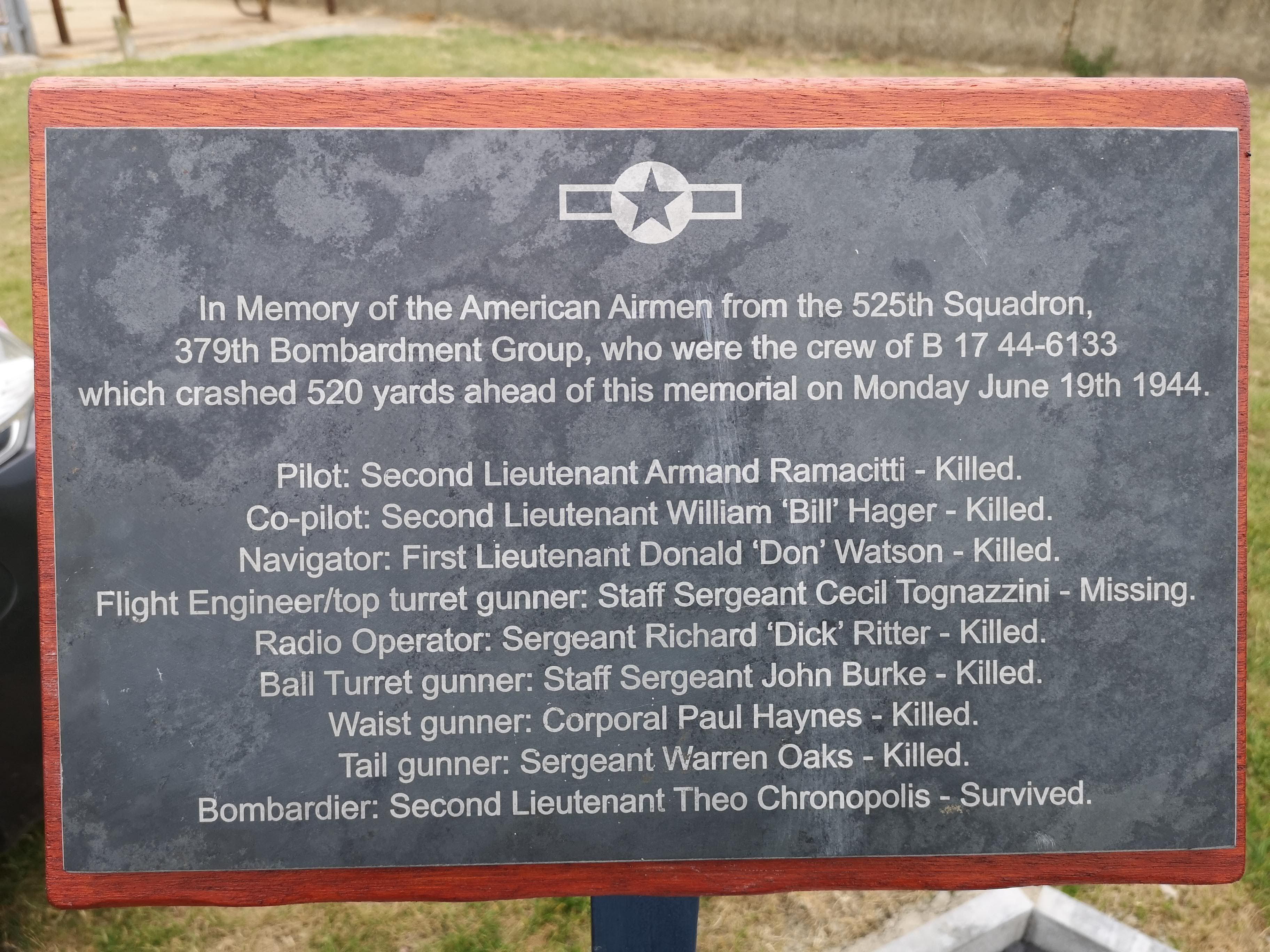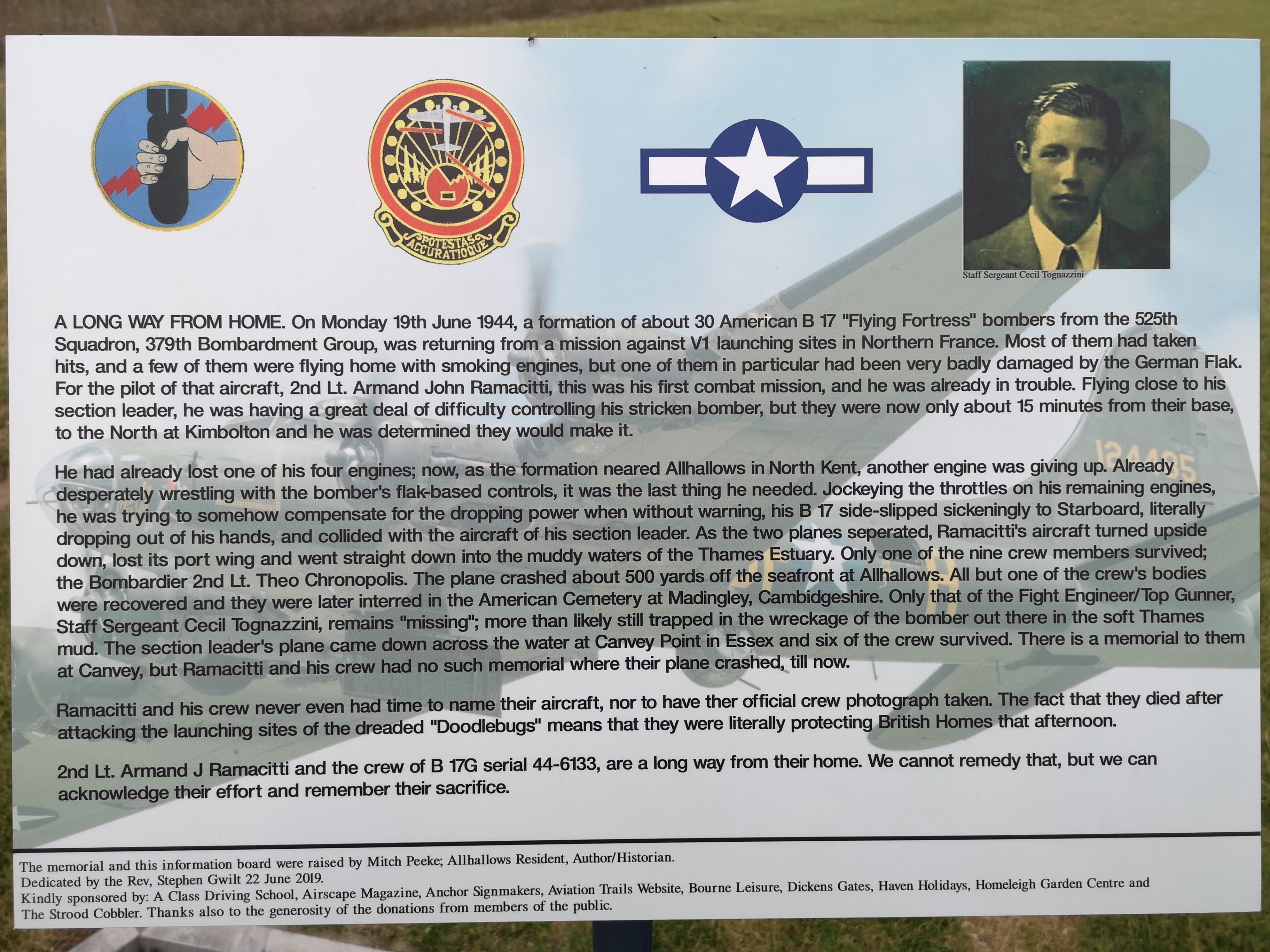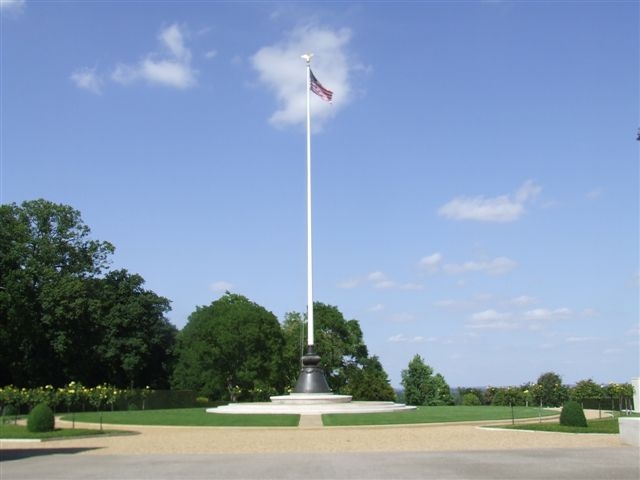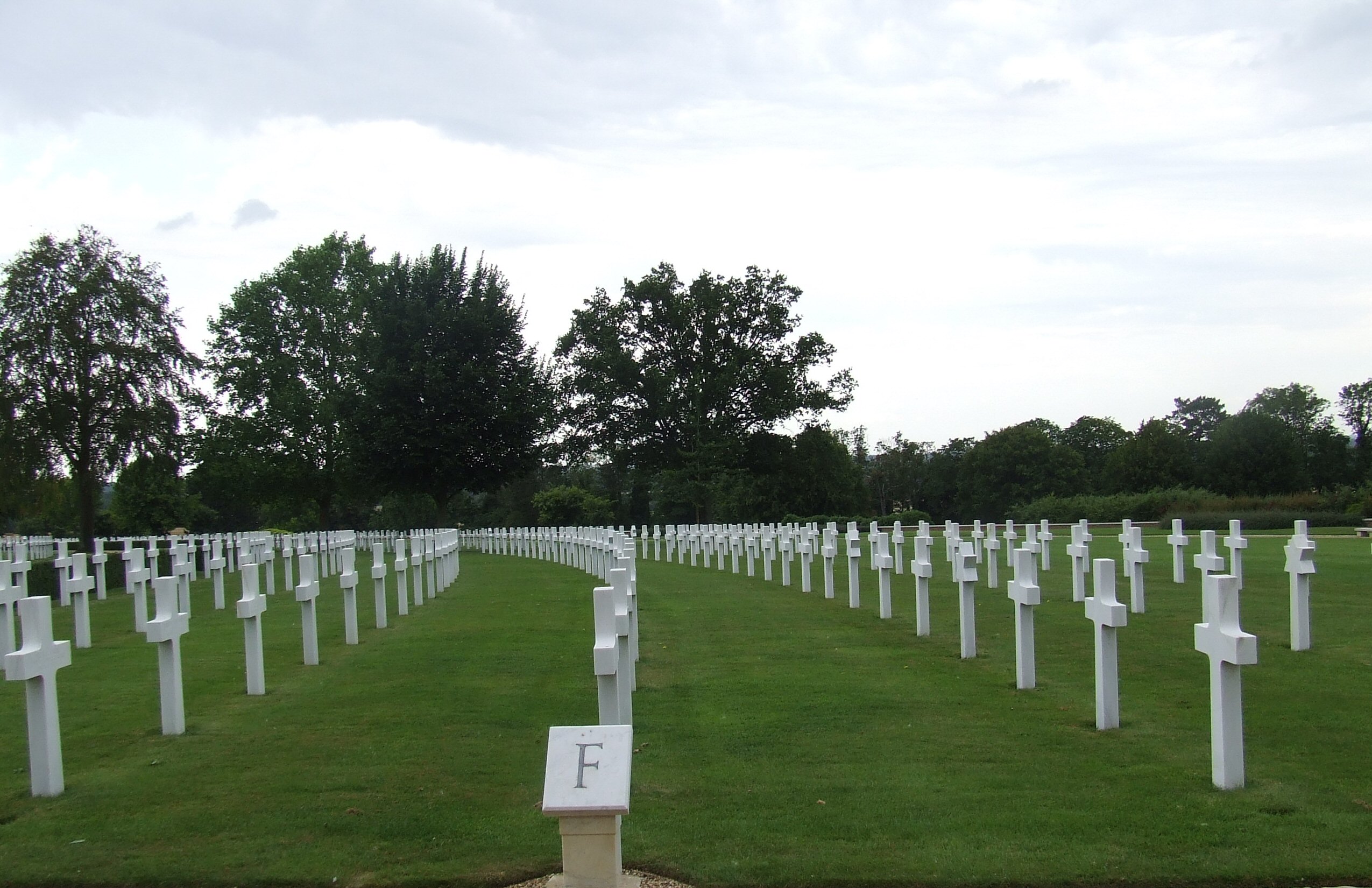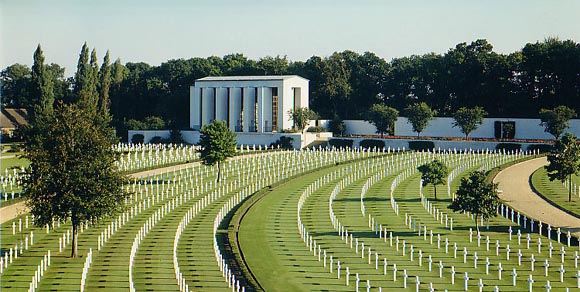Born 1923 in Vermont, entered service from Cleveland, Ohio according to enlistment record. Ranked S/Sgt on MACR 6984.
Awards: Purple Heart
The death of a Heavenly Body - the story of the World War II B-17G American aircraft collision on 19th June 1944, one of which crashed at Canvey Point onto the salt marshes.
It was only the third bombing mission in the brand new B-17G Flying Fortress aircraft recently named Heavenly Body II by its crew of American airmen.
It was to be Pilot Lloyd Burns 29th combat mission (only one more flight to go and his European tour of duty would be complete and he'd return to the USA)
The crew had commissioned their brand new B-17G Flying Fortress heavy bomber aircraft very recently and had quickly nicknamed her Heavenly Body II in order to keep the name flying, the original Heavenly Body having been lost in combat; it was only their third mission in the new aircraft.The assignment had been out to enemy controlled France to bomb a suspected 'V1' rocket site located at Zudausques that would have otherwise rained its own particular style of terror on London and the South East of England. They were returning from France flying North, to their airbase at Kimbolton in Huntingdonshire. It was approaching 18:15Hours and the River Thames was coming into view in between the clouds as they crossed the county of Kent far below. Flying at height of around 17,000 feet through cloud haze visibility was reduced to around 1000 yards. Left wing man, Pilot Armand Ramacitti was having difficulty with his aircraft, referred to as 44-6133 (it had not been given a nickname) however Lloyd Burns in Heavenly Body II 42-97942 at this stage was unaware of the difficulties Ramacitti was experiencing. Pilot Ramacitti's aircraft encountered thick cloud and worsening visibility and accordingly at this stage he was almost certainly flying on instruments alone. He lifted the B-17 out of formation above and slightly ahead of the lead aircraft, Heavenly Body II, his concerns were most likely for the aircraft behind him that were flying into the thick smoke from his failing engine adding to the lack of their own visibility and increasing the risk of a collision.
Pilot Lloyd Burns had swapped seats with his co- pilot Lt. Kauffman to give him experience in flying in the left hand seat as Kauffman was soon hoping to get his own crew. This wasn't particularly unusual as crew members swapped around from flight to flight between both aircraft and jobs, they were very young and often relished the chance to try out different roles; in fact Lloyd Burns himself was only 19 years old at the time of the collision! The last moments of the aircraft Heavenly Body II seemed to be controlled and was seen to take decisive action saving Canvey Island from a disaster! As the aircraft veered away to the West towards London following the impact, this was also towards the industrial area and oil storage depot on the island. Then miraculously the aircraft turned again (this coincided with crew members bailing out close to Hole Haven Creek) swinging back toward Southend over a more built up area of Canvey now directly in line with Marine Parade, looking as though it would attempt a landing on the mud flats beyond! But it overshot the suspected target area, circled and then nosedived towards the estuary mud just off Canvey Point,where it crashed. As a result of the collision only Theodore Chronopolos 2nd Lieutenant, Bombardier on-board 44-6133 (the unnamed aircraft) survived.Of the remaining crew 'they all perished', the airframe was so badly distorted in the impact and it fell to Earth so steeply that it would have been near impossible for them to escape! This then is the list of casualties on-board 44-6133 all of whom are either interred or commemorated at Cambridge.
Pilot Armand Ramacitti
Co-pilot 2nd Lt. William J Hager
Navigator 2nd Lt. Donald F Watson
Gunner S/Sgt. Richard Ritter
Gunner S/Sgt. John P Burke
Gunner Sgt. Warren G Oaks
Gunner Cpl. Paul K Haynes
Gunner S/Sgt. Cecil A Tognazzini
On Heavenly Body II, 42-97942 the following casualties:
Co-pilot Fred S Kaufman – interred/commemorated at Cambridge
Navigator Edward N Sadler –interred/commemorated at Cambridge
Gunner Louis V Schulte –burial place unknown
The Heavenly Body II aircraft continued to remain in the air following the collision for sufficient time that six of its crew managed to escape.
Pilot Lloyd L Burns
Bombardier Jack L Gray
Top Turret Gunner Leonard F Gibbs
Ball Turret Gunner William H Farmer
Tail Gunner Richard Andrews
Radio Op/Gunner Leroy J Monk
Following the accident an inquest was chaired by:
Robert S Kittel Lt. Colonel, Air Corps PRESIDENT.
Robert D Brown, Major, Air Corps.
Clay W Hedges, Air corps, RECORDER.
The official description and verdict is as follows:
The formation was returning from a combat mission and had reached the English coast in formation, flying through a haze between 18,000 and 21,000 feet. Aircraft #44-6133 went through the haze and collided with aircraft #42-97942 (Heavenly Body II)hitting the plane just behind the Pilot's compartment near the top turret. As a result of the crash one plane went down in a spin, the other plane disintegrated and fell apart, falling to the ground in pieces.
Born 1923 in Vermont, entered service from Cleveland, Ohio according to enlistment record. Ranked S/Sgt on MACR 6984.
Awards: Purple Heart
The death of a Heavenly Body - the story of the World War II B-17G American aircraft collision on 19th June 1944, one of which crashed at Canvey Point onto the salt marshes.
It was only the third bombing mission in the brand new B-17G Flying Fortress aircraft recently named Heavenly Body II by its crew of American airmen.
It was to be Pilot Lloyd Burns 29th combat mission (only one more flight to go and his European tour of duty would be complete and he'd return to the USA)
The crew had commissioned their brand new B-17G Flying Fortress heavy bomber aircraft very recently and had quickly nicknamed her Heavenly Body II in order to keep the name flying, the original Heavenly Body having been lost in combat; it was only their third mission in the new aircraft.The assignment had been out to enemy controlled France to bomb a suspected 'V1' rocket site located at Zudausques that would have otherwise rained its own particular style of terror on London and the South East of England. They were returning from France flying North, to their airbase at Kimbolton in Huntingdonshire. It was approaching 18:15Hours and the River Thames was coming into view in between the clouds as they crossed the county of Kent far below. Flying at height of around 17,000 feet through cloud haze visibility was reduced to around 1000 yards. Left wing man, Pilot Armand Ramacitti was having difficulty with his aircraft, referred to as 44-6133 (it had not been given a nickname) however Lloyd Burns in Heavenly Body II 42-97942 at this stage was unaware of the difficulties Ramacitti was experiencing. Pilot Ramacitti's aircraft encountered thick cloud and worsening visibility and accordingly at this stage he was almost certainly flying on instruments alone. He lifted the B-17 out of formation above and slightly ahead of the lead aircraft, Heavenly Body II, his concerns were most likely for the aircraft behind him that were flying into the thick smoke from his failing engine adding to the lack of their own visibility and increasing the risk of a collision.
Pilot Lloyd Burns had swapped seats with his co- pilot Lt. Kauffman to give him experience in flying in the left hand seat as Kauffman was soon hoping to get his own crew. This wasn't particularly unusual as crew members swapped around from flight to flight between both aircraft and jobs, they were very young and often relished the chance to try out different roles; in fact Lloyd Burns himself was only 19 years old at the time of the collision! The last moments of the aircraft Heavenly Body II seemed to be controlled and was seen to take decisive action saving Canvey Island from a disaster! As the aircraft veered away to the West towards London following the impact, this was also towards the industrial area and oil storage depot on the island. Then miraculously the aircraft turned again (this coincided with crew members bailing out close to Hole Haven Creek) swinging back toward Southend over a more built up area of Canvey now directly in line with Marine Parade, looking as though it would attempt a landing on the mud flats beyond! But it overshot the suspected target area, circled and then nosedived towards the estuary mud just off Canvey Point,where it crashed. As a result of the collision only Theodore Chronopolos 2nd Lieutenant, Bombardier on-board 44-6133 (the unnamed aircraft) survived.Of the remaining crew 'they all perished', the airframe was so badly distorted in the impact and it fell to Earth so steeply that it would have been near impossible for them to escape! This then is the list of casualties on-board 44-6133 all of whom are either interred or commemorated at Cambridge.
Pilot Armand Ramacitti
Co-pilot 2nd Lt. William J Hager
Navigator 2nd Lt. Donald F Watson
Gunner S/Sgt. Richard Ritter
Gunner S/Sgt. John P Burke
Gunner Sgt. Warren G Oaks
Gunner Cpl. Paul K Haynes
Gunner S/Sgt. Cecil A Tognazzini
On Heavenly Body II, 42-97942 the following casualties:
Co-pilot Fred S Kaufman – interred/commemorated at Cambridge
Navigator Edward N Sadler –interred/commemorated at Cambridge
Gunner Louis V Schulte –burial place unknown
The Heavenly Body II aircraft continued to remain in the air following the collision for sufficient time that six of its crew managed to escape.
Pilot Lloyd L Burns
Bombardier Jack L Gray
Top Turret Gunner Leonard F Gibbs
Ball Turret Gunner William H Farmer
Tail Gunner Richard Andrews
Radio Op/Gunner Leroy J Monk
Following the accident an inquest was chaired by:
Robert S Kittel Lt. Colonel, Air Corps PRESIDENT.
Robert D Brown, Major, Air Corps.
Clay W Hedges, Air corps, RECORDER.
The official description and verdict is as follows:
The formation was returning from a combat mission and had reached the English coast in formation, flying through a haze between 18,000 and 21,000 feet. Aircraft #44-6133 went through the haze and collided with aircraft #42-97942 (Heavenly Body II)hitting the plane just behind the Pilot's compartment near the top turret. As a result of the crash one plane went down in a spin, the other plane disintegrated and fell apart, falling to the ground in pieces.
Family Members
Sponsored by Ancestry
Advertisement
Explore more
Sponsored by Ancestry
Advertisement
